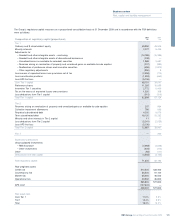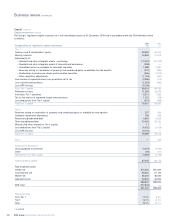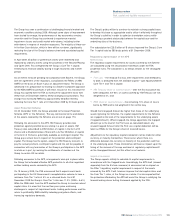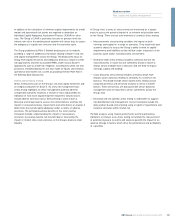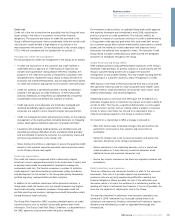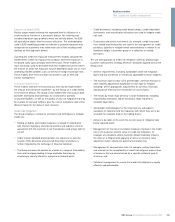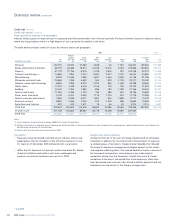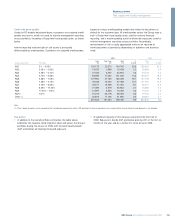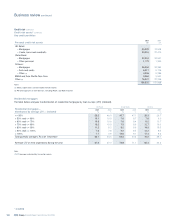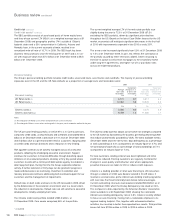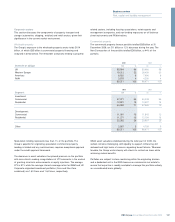RBS 2009 Annual Report Download - page 130
Download and view the complete annual report
Please find page 130 of the 2009 RBS annual report below. You can navigate through the pages in the report by either clicking on the pages listed below, or by using the keyword search tool below to find specific information within the annual report.Business review continued
Credit risk continued
Retail collections and recoveries continued
In the UK and Ireland, the Group has introduced new forbearance
policies for customers in financial difficulty based on various
government sponsored schemes, customer affordability and prospects.
In the US there has been an increase in agreed loan modification
programmes, including those sponsored by the US government.
Credit risk framework
The approach taken to managing credit risk varies significantly between
wholesale portfolios (loans, and other products giving rise to credit risk,
to all but the smaller corporate customers, to financial institutions and to
government entities) and retail portfolios (secured and unsecured loans
and related products to individuals and small businesses).
Wholesale portfolios
Wholesale risk limits are aggregated at the counterparty level to
determine the level of credit approval required and to facilitate
consolidated credit risk management.
The credit approval process has two stages, assessment and decision.
Credit applications for corporate customers are prepared by
relationship managers in the units originating the credit exposures or by
the relationship management team with lead responsibility for a
counterparty where a customer has relationships with different divisions
and business units across the Group. This includes the assignment of
risk parameter estimates (probability of default, loss given default and
exposure at default) using approved models.
Credit approval authority is discharged by way of a framework of
individual delegated authorities that requires at least two individuals to
approve each credit decision, one from the business and one from the
credit risk management function. Both parties must hold sufficient
delegated authority under the Group-wide authority grid. The level of
authority granted to an individual is dependent on their experience and
expertise with only a small number of senior executives holding the
highest authority provided under the framework.
Daily monitoring of individual counterparty limits is undertaken. For
certain counterparties early warning indicators are also in place to
detect deteriorating trends of concern in limit utilisation or account
performance. A framework is also in place to monitor changes in credit
quality at the portfolio level.
As a minimum, credit relationships are reviewed and re-approved
annually. The renewal process addresses: borrower performance,
including reconfirmation or adjustment of risk parameter estimates; the
adequacy of security; and compliance with terms and conditions.
Retail portfolios
Retail business operations require a large volume of small scale credit
decisions, typically involving an application for a new product or a
change in facilities on an existing product. The majority of these
decisions are based upon automated strategies utilising best practice
credit and behaviour scoring techniques. Scores and strategies are
typically segmented by product, brand and other significant drivers of
credit risk. These data driven strategies utilise a wide range of credit
information relating to a customer including, where appropriate,
information across a customer’s holdings.
A small number of credit decisions are subject to additional manual
underwriting by authorised approvers in specialist units. These include
higher value more complex small business transactions and some
residential mortgage applications.
Divisional risk management committees focus on portfolio level decisions
which drive credit quality, changes to policy and strategy, and the setting of
credit scorecard cut-offs. The divisional risk management committees are
also responsible for reviewing ongoing performance of the business and, if
necessary, making or recommending adjustments to risk appetite.
Credit risk measurement
Credit risk models are used throughout the Group to support the
quantitative risk assessment element of the credit approval process,
ongoing credit risk management, monitoring and reporting and portfolio
analytics. Credit risk models used by the Group may be divided into
three categories.
Probability of default/customer credit grade (PD)
These models assess the probability that a customer will fail to make full
and timely repayment of their obligations. The probability of a customer
failing to do so is measured over a one year period through the
economic cycle, although certain retail scorecards use longer periods
for business management purposes.
•Wholesale businesses: each counterparty is assigned an internal
credit grade which is in turn assigned to a default probability range.
There are a number of different credit grading models in use across
the Group, each of which considers risk characteristics particular to
that type of customer. The credit grading models score a
combination of quantitative inputs (for example, recent financial
performance) and qualitative inputs, (for example, management
performance or sector outlook). Scores are then mapped to grades
within each model. Grades are calibrated centrally to default
probabilities. Obligor grades can, under certain circumstances, be
cascaded to other borrowing entities within the obligor group where
there is sufficient dependence on the graded entity. The credit
grades for sovereign and central bank entities are assigned by a
specialist country risk analysis team using a sovereign grading
model. This team is independent of the origination function and is
comprised of economists. Certain grading models also cover
customers or transactions categorised as specialised lending (for
example certain types of investment property and asset finance
such as shipping).
•Retail businesses: each customer account is separately scored using
models based on the most material drivers of default. In general,
scorecards are statistically derived using customer data. Customers
are assigned a score which in turn, is mapped to a probability of
default. The probability of default is used within the credit approval
process and ongoing credit risk management, monitoring and
reporting. The probabilities of default are used to group customers
into risk pools. Pools are then assigned a weighted average
probability of default using regulatory default definitions.
RBS Group Annual Report and Accounts 2009128





